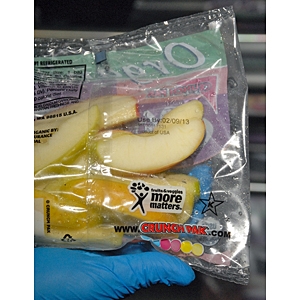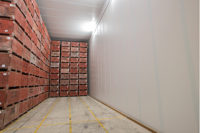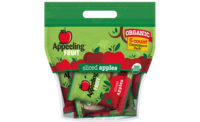Crunch Pak, a Cashmere, Wash.-based producer of sliced apple products, was founded in 2001 by a consortium of apple growers who believed people would  consume more apples if they were easier to eat. So, the firm worked with outside suppliers to develop a process that included both the solution of vitamin C and calcium to prevent product spoilage and the breathable packaging that maintains the crispness and freshness of raw apples after they are sliced.
consume more apples if they were easier to eat. So, the firm worked with outside suppliers to develop a process that included both the solution of vitamin C and calcium to prevent product spoilage and the breathable packaging that maintains the crispness and freshness of raw apples after they are sliced.
Crunch Pak started with just two offerings— sweet and tart apples. Today, the company’s products are sold at Costco and in supermarkets and convenience stores across North America. A new 39,000-square-foot plant expansion was completed in 2012 to handle its rapid sales growth. With the expanded space, Crunch Pak’s workforce of 900 can now process and ship approximately 1 million pounds of raw product per week. Crunch Pak’s product offerings have also evolved over the past decade and now include a full line of snack items that pair sliced apples with caramel or fruit dips, cheese, pretzels, grapes and more.
Challenged by track-and-trace regulations
Food safety is paramount in the food industry and even more critical with fresh produce, due to its short life span. The ability to track-and-trace shipments can help producers improve the recall process, should that become necessary, and increases consumer confidence in the supply chain.
Traceability is implemented through the assignment and printing of a GTIN (Global Trade Item Number) code on shipping cartons and pallets. However, the new coding regulations—which call for produce growers and packers to apply the GTIN code, along with lot number and human readable product information to allow retailers to trace each product’s origins?posed a major challenge for Crunch Pak.
“In our apple packaging and case packing operations, the ink jet labeling and label printing equipment we had been using did not have the software capability needed to integrate the required information into GTIN bar codes,” says Todd Danko, director of operations. “They also didn’t deliver the print quality to print the scannable barcodes accurately and consistently in our cold room packaging environments where temperatures are kept at just below freezing.”
In addition, Crunch Pak was looking to streamline its processes for both bag printing and carton printing in order to speed up these tasks to achieve higher throughput.
“Given these challenges, we decided it was time to source newer printing technologies that could help reduce time and labor while fully complying with both FDA and PTI traceability regulations,” Danko adds.
Installing key coding solutions
After evaluating marketplace offerings and seeing a trial demonstration from Videojet Technologies Inc., Wood Dale, Ill., Crunch Pak decided to source its new equipment from Videojet because the vendor offered robust, ‘smart’ printer and labeling options and provided deep domain expertise on networked system and traceability requirements.
Crunch Pak has since purchased 23 Videojet P3400 Label Printer Applicators and 10 Videojet DataFlex Plus printers that are used for printing the ‘use by’ date, GTIN manufacturing code and information, lot number, ingredients, customer number and country of origin.
The P3400 model, for example, is a label printer applicator that prints high-resolution barcodes and text on paper labels and performs accurate, precise label placement onto the shipping carton. The Videojet DataFlex Plus is a rugged thermal transfer overprinter that fully integrates into production lines and operates flawlessly, even in tough conditions such as Crunch Pak’s ultra-cool packing rooms.
The DataFlex Plus printers are deployed on the vertical form-fill-seal bagging machine lines and the rigid tray line packaging rooms—printing GTIN-compliant information on pre-printed labels from roll stock. In addition, the P3400s print and apply labelers deployed on the case coding lines are also printing GTIN-compliant data on adhesive labels that get applied to cartons in the packing and shipping area. Both Videojet printing and labeling solutions run 18 hours per day, six days a week throughout the year, and about 50 Crunch Pak employees interact with the printers in these areas.
All of the printers are networked and programmed by a packaging supervisor responsible for set-up and operations. Information to be coded is accessed through the company’s server using Microsoft Access. These files are set up by both maintenance personnel and production management.
Implementation and training
On-site implementation and training of Crunch Pak’s packaging supervisor, line workers and maintenance personnel took about two weeks total.
“After all the units were installed and we worked through some initial processing issues, Videojet spent several days training our personnel in how to program and operate the equipment,” says Danko. “Once operational, both sets—the networked printers and print-and-apply labelers—worked extremely well. Our workers like them much better and found them easier to use and maintain than the legacy printers. The service and technical support we have received from Videojet have been excellent as well.”
Operational and business benefits
Since implementing the Videojet printing solutions, Crunch Pak has experienced numerous operational and business benefits.
“We now have complete GTIN compliance, which is a great competitive advantage for us,” Danko says. “In addition, we are seeing lower label and labeling labor costs, significantly reduced maintenance costs and few human errors in labeling, thanks to the code accuracy of the networked system.”


